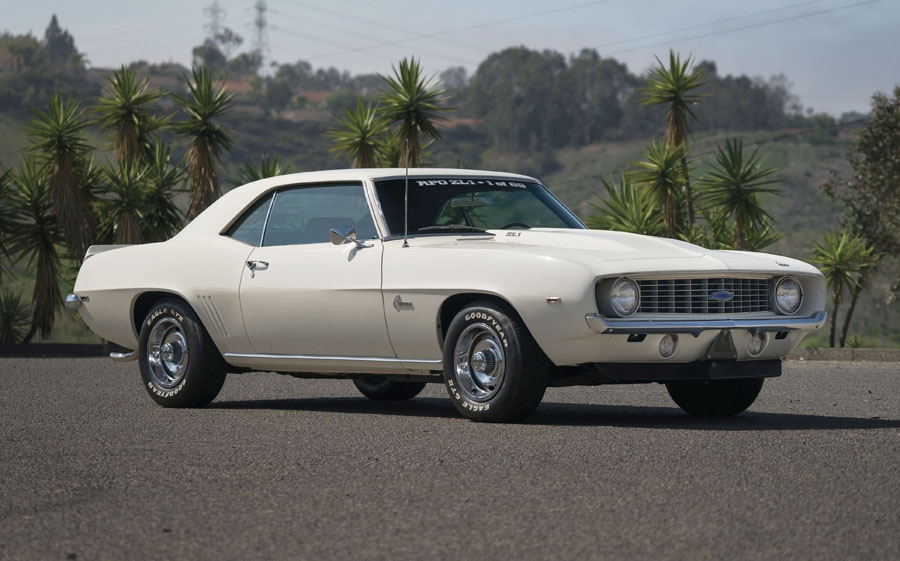SCM Analysis
Detailing
| Vehicle: | 1969 Chevrolet Camaro ZL1 |
| Years Produced: | 1969 |
| Number Produced: | 69 |
| Original List Price: | $7,300 |
| SCM Valuation: | Median to date, $525,300; high sale, $715,000 |
| Tune Up Cost: | $300 |
| Distributor Caps: | $50 (NOS part) |
| Chassis Number Location: | Dashboard driver’s side, driver’s door decal |
| Engine Number Location: | Partial VIN and code on machined pad on block, ahead of passenger’s cylinder head |
| Website: | www.yenko.net |
| Alternatives: | 1970 Plymouth Hemi ’Cuda Super Stock, 1969 Ford Mustang Boss 429, 1969 Chevrolet Corvette L88 |
| Investment Grade: | A |
This car, Lot 510, sold for $404,250, including buyer’s premium, at Auctions America’s sale in Fort Lauderdale, FL, on April 2, 2016. The last time we saw this car sell was at the Mecum Indy auction in May 2011, when it brought $323,500. We profiled it in the August 2011 issue of our sister magazine, Sports Car Market.
A faster big block
By 1968, the 427-powered Yenko and Nickey cars had been burning up the record books and giving Chevrolet a leg up in the world of hushed corporate-assisted racing. Chevrolet had been working on an all-aluminum big block for the Can-Am series and for Corvette racing, and Fred Gibb got together with Dick Harrell to request a run of Camaros built by the factory with the new engine. Gibb contacted Chevy performance specialist Vince Piggins, the man with the say over which COPO cars could and would be built, and he agreed to it — so long as 50 were ordered.
With that, COPO number 9560 was born, and the heart of it was that ZL1 engine. It was basically an updated L88 with an aluminum block — an L88 on a diet. The ZL1’s job was to smoke the competition by 4th gear, and with real-world horsepower in excess of 500 ponies and the weight of a standard small-block 327, it did that job especially well.
The ZL1 was an all-out race engine. A lot of specialized parts went into this package, including transistorized ignition with a specific module installed behind the grille on the front brace, a 1111927 distributor, aluminum high-rise dual-plane intake 3933198, high-lift long-duration cam with dual pattern lobes, and the Chevy 12 bolt “BE” differential paired with either a TH400 or the Muncie M22. All the good hardware was used, and the result was shattering.
When Cars Illustrated magazine tested the third ZL1 made, it blazed a 13.16-second ET at 110 mph with Roger Huntington at the wheel. Harrell’s car in Kansas did the quarter mile in 12.14 at 117 mph with slicks and headers.
But the cars were prohibitively expensive at over $7,000 new, and as such, the package was a hard sell. Only 69 were built, and it took dealers a lot longer than expected to move them off their lots.
Great history
This car was #53 out of the 69 made. The ZL1 Camaro helped form the roots of Pro Stock racing, with stunning NHRA record-setting performance, and it was this very car that set the record. In addition, it has a provenance most owners can only dream of, with Ed Cunneen — a ZL1 guru — as the first titled owner, along with Robert Lyle, a known ZL1 Chevrolet dealer.
In addition, the car has a long association with Floyd Garrett’s Muscle Car Museum and was given a show-winning restoration to the highest standard while in Garrett’s possession. This one was finished in Dover White with black interior and equipped with AM radio, Rally wheels, rear spoiler and the M22. The only flaw is the original engine is gone. In its place is a correct ZL1 code replacement block.
With factory-built race cars, missing engines come with the territory. With racers, you pay a premium for a numbers-matching example, but other intangible factors have as much bearing on the price, such as racing history, ownership and documentation. A known race car is valued even if it’s missing some of its born-with hardware. I’ve seen a rebodied ZL1 sell for not much less than what was paid here.
A solid jump
ZL1 Camaro prices have been on a roller coaster ride, with the nosebleed high of $840,000 for the Gibbs ZL1 in 2005 (ACC# 39570) to the aftermath of 2008 to 2012, when the market finally gained footing for a recovery.
High-profile, high-dollar muscle takes the fall first in a correction, but they’re also indicators of a recovery.
When this car sold at Mecum Indianapolis for $323,300, we called it out as well bought. Now, five years and $80,000 later, the sentiment still stands. A premium is paid for the 4-speed examples, and recent activity reveals good stick-shift cars can bring over $500k. Automatics are bound to play catch-up, but they will.
This car has a nicer grille now, but that has little to do with the boost in price. The real reason for the 25% gain has to do with buying a sure thing. If you can tolerate the dips and swings in the market and enjoy blistering speed through chambered exhaust, you can’t lose with a ZL1. I’m still calling this one a good buy, and I think there’s room to grow.
(Introductory description courtesy of Auctions America.)
